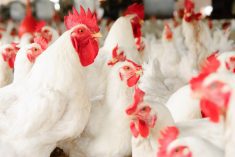Canada’s chicken processors have a year to make plant-level changes to cut the risk of salmonella infection from frozen raw breaded chicken goods.
The Canadian Food Inspection Agency said March 12 it will require processors to identify salmonella as a hazard likely to occur in these products — and to “implement changes in order to produce an end product that reduces salmonella to below a detectable amount.”
The industry gets a 12-month “implementation period” to work with the CFIA to make such changes, starting immediately, the agency said.
Read Also

U.S. livestock: Cattle strength continues
Cattle futures on the Chicago Mercantile Exchange were stronger on Friday, hitting fresh highs to end the week.
Products covered under the requirement include any frozen raw breaded chicken products such as chicken nuggets, chicken fingers, chicken strips, popcorn chicken and chicken burgers that appear “ready to eat” and are packaged for retail sale. Turkey, duck and quail products aren’t included.
Frozen raw breaded “stuffed” chicken products won’t be included under the requirement “at this time,” the agency said, adding it plans to work with industry “to ensure a common understanding of which products are affected and which are not.”
The new requirements follow “extensive efforts” by food safety officials and industry to boost consumer awareness that the products in question need to be fully cooked before consumption, CFIA said. It also noted “significant attempts by the industry to improve labelling and cooking instructions on packages.”
Despite those moves, the agency said, “frozen raw breaded chicken products continue to be identified as a source of salmonella infection in Canada.”
Incidence of salmonella illness in Canada has “steadily increased” over the last 10 years, the agency said, driven by salmonella enteritidis (SE), which is the most common strain in the food supply and often associated with poultry.
The most recent such outbreak under federal and provincial investigation so far involves 30 people sickened with SE between May 2017 and last month across four provinces, including 17 in Ontario. Of the 30, four were hospitalized.
According to the Public Health Agency of Canada, investigation findings so far point to exposure to poultry, including frozen raw breaded chicken products, as a source of the illness.
While frozen raw breaded chicken products often look like they’re “pre-cooked” or “ready-to-eat,” CFIA said, they still contain raw chicken and are meant to be handled the same way as other raw poultry.
Frozen raw breaded chicken products and raw poultry pieces must be cooked to an internal temperature of at least 74 C (165 F) to ensure they’re safe to eat, according to PHAC.
Messaging
The new requirement announced March 12 “focuses the responsibility on the poultry industry and represents a fundamental change to existing requirements for frozen raw breaded chicken products,” CFIA said.
The industry in 2015 already voluntarily added labelling on frozen raw breaded chicken products with more “prominent and consistent messaging,” CFIA said, using wording such as “raw,” “uncooked” or “must be cooked.”
The new labeling, CFIA said, had also included “explicit” instructions not to microwave the product. The industry also voluntarily added cooking instructions on the products’ inner-packaging bags.
“The poultry industry’s objective is to provide consumers with affordable, safe poultry products, every day,” Robin Horel, CEO of the Canadian Poultry and Egg Processors Council, said March 12 in CFIA’s release. “We will continue to work with CFIA to ensure consumers have access to safe frozen raw breaded chicken products.” — AGCanada.com Network















